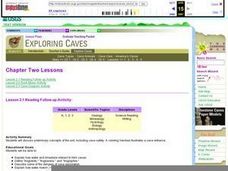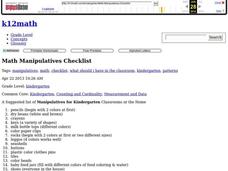Curated OER
What is Money? Learn the Role of Money in a Free Market System
Learners view a seashell and listen as the teacher explains that these were sometimes used as money. They listen as the teacher lectures on medium of exchange, barter, and commodity. Students determine the number of chickens it would...
Curated OER
Three Dimensional Art of Vertebrates and Invertebrates
Students, during this twelve week series of lessons, learn basic anatomy through life sketches of human skeletons and shells. They learn fundamentals of line and convey life through sketches learning science through art.
Curated OER
Shells, Shells, Shells
Middle schoolers read text to determine main idea and supporting details and facts. They use the shell web links to inquire about the various types of shells. Students use Inspiration templates to make a mobile about shells.
Curated OER
Shells and Subshells
Students explore how to show evidence of subshells and electron filling on the visual scale. They examine subshell filling and evaluate unknowns based on the atomic emission spectrum. Students design an experiment to identify colors of...
Curated OER
Multiplying in Any Order
For this mathematics worksheet, 2nd graders use counters to show an array. Then they write the multiplication fact for that array. Students also identify if the reverse of a multiplication fact is equal and explain why.
Curated OER
Shells Around the World
Students research a geographical region that contains shells. In this shells from around the world lesson, students take a field trip to a local shell shop (if possible) and then work in groups to research a geographical region such as...
Curated OER
Features of Shells
Students create a new shell. In this shell features instructional activity, students different types of shells, discuss their special features and talk about how animals use shells. Students use the Internet to research information on...
Curated OER
Exploring How Rocks Are Formed
These lessons produced by the Illinois State Museum are quite good. In this one, third and fourth graders are introduced to the three basic types of rocks: igneous, sedimentary, and metamorphic. They perform activities which help them...
Curated OER
Fossils!
Young scholars explore what fossils are, how they are formed, what different types there are and why they are significant to both our present and past geology history. They participate in a hands on fossil observation of their choice and...
Curated OER
Fossil Find
Students investigate the practice of digging for fossils. They participate in a mock dig of fossils using real bones and other artifacts. Then students dig through sand in order to go through the simulation. Students make observations...
Curated OER
What Contains Carbon?
Young scholars explore elements by analyzing everyday objects and materials in class. In this carbon lesson, students define several vocabulary terms such as carbon dioxide, hydrocarbon, and carbonate. Young scholars view a group of...
Curated OER
Introduce Vocabulary: Dolphin's First Day (Zoehfeld)
Travel out to sea as scholars learn vocabulary in context through Kathleen Zoehfeld's informational book Dolphin's First Day. Go over the new words scholars will hear before reading: approach, coast, expert, feeble, gaze, murky, propel,...
Curated OER
Math Review for Grade 2 (2.6)
In this math review for grade 2 (2.6) worksheet, 2nd graders answer 25 multiple choice questions in standardized test format about addition, subtraction and bar graphs.
Curated OER
Reading Follow-up Activity
Pupils color a worksheet while discussing characteristics and composition of caves.
Curated OER
Line and Shading = Shape and Form
Young scholars collect natural objects and draw these objects with and without shading.
Curated OER
Exploring How Rocks Are Formed
Students examine the three types of rocks. They discover the processes that occur so each type of rock can be formed. They participate in activities to help them see how rocks are formed.
Curated OER
Exploring Caves
Students explore the various characteristics of caves. Through class discussion and hands on activities, students identify what forces converge in the creation of a cave. They complete review activities at the conclusion of the lesson....
Curated OER
Back to the Past
Students label fossil imprints. For this Geology lesson, students view fossil imprints of several items. Students explain what a fossil is.
Curated OER
Patterns
Explore early algebra by participating in a pattern identification activity using a random assortment of different household materials. The class creates, completes, and analyzes different patterns with the help of leggos, buttons,...
Curated OER
Homes for Hermit Crabs
Students discover the differences between hermit crabs and mollusks and identify their parts. After reading a story about hermit crabs, they complete an anatomy worksheet. For another activity, students fold and cut a diagram of a hermit...
Curated OER
Sight
Students discover how the sense of sight helps us recognize each other and explore color, motion and distance.
Curated OER
1, 2, 3 Hooray for Number Equivalency!
Students represent equivalent amounts using concrete materials, number symbols, and number words.
Curated OER
Shattered Images Value Study
Students create cubist drawings using grids and enlargement.
Curated OER
Patterns in Nature
Students examine places in nature where patterns can be observed by looking through a number of books after watching a teacher PowerPoint presentation. They illustrate a pattern in nature.
Other popular searches
- Classifying Seashells
- Counting Seashells
- Florida Seashells
- Seashells Chime
- Identify Seashells
- Drawing Seashells
- Making Seashells
- Letters and Seashells
- Visual Art Seashells
- Classification of Seashells
- Subtraction Seashells

























